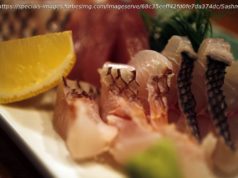An islet north of Hokkaido – one that helped Japan mark its territorial waters – has vanished, and no-one is sure when or precisely how.
The northeastern tip of Hokkaido (left) near the smaller Kunashir Island, the latter of which is controlled by Russia. The swirls here are ice floes, which may have destroyed the tiny islet. JSC/NASA
In this day and age, with anthropogenic climate change far from being under any sort of control, it’s to be expected that islands will disappear beneath the rising seas. As Hurricane Walaka recently demonstrated, sometimes this process is a little more abrupt than usual: this Category Five beast annihilated an island within Hawaii’s Papahānaumokuākea Marine National Monument essentially overnight.
Now, on the other side of the Pacific, something similarly curious is afoot. As reported by The Asahi Shumbun, an islet off the highest coast of Japan has vanished. No typhoons passed through the area, though, so what happened?
The islet, named Esanbehanakitakojima, is uninhabited. You wouldn’t really want to live there; found near the northern edge of Hokkaido, the northernmost major Japanese island, the waters are frigid and the winters are incredibly harsh. It was already barely above the high tide height too – no more than 1.4 meters (4.6 feet) – meaning it only barely qualified as an island under international maritime law.
This islet is one of 158 that the Japanese government, in 2014, decided to use to physically mark where its territorial boundaries lie. As noted by the Guardian, this is increasingly important a task these days: China, a regional rival, is somewhat aggressively expanding its territory by laying claim to islands that, in some cases, it’s building itself.
In this case, the islet lies in an area that is heavily disputed by the Japanese and Russian governments. At the close of the Second World War, the Soviet Union began invading parts of Japan nearest their own shores. The detonation of the two nuclear weapons in Hiroshima and Nagasaki in August 1945 by the Americans convinced them to stop their incursion. The islands they did manage to grab, which they refer to as the Kurils, are still claimed by Japan – and Esanbehanakitakojima sits close by.
At, least it used to sit close by. In September, the author of a picture book on Japan’s hidden islands decided to visit Sarufutsu – the village nearest the islet – as he worked on a sophomore effort. Looking for Esanbehanakitakojima, he found it wasn’t there.
Members of the fishing industry then went out to find it, and confirmed that it wasn’t where the charts marked its position. At present, the Japanese Coast Guard is currently looking for it, but it’s not likely they’ll find anything.
It’s not known at this point when it disappeared. The last time it was recorded in any official capacity was 1988, when the Geospatial Information Authority of Japan described it as an islet on a sea chart, according to CNN. It’s also anyone’s guess as to what made it disappear, although being such a small islet already, strong wind or wave action could have simply eroded it over time. Drifting ice from the chilly Sea of Okhotsk could have also taken it out, but this of course wasn’t directly observed.
Either way, it’s not great news for the Japanese government. If it’s confirmed to have sunk beneath the waves, then they’ve just lost around 500 meters (1,640 feet) of territorial waters that Russia could, if they wanted, claim.
Japan’s territorial boundaries are often in flux. In 2013, for example, a huge underwater eruption caused an island to rise out of the sea 1,000 kilometers (620 miles) south of Tokyo. It proved to be so prolific an eruption that it linked up with its pre-existing neighbour, Nishinoshima, and was soon colonized by vegetation and sea birds. The Japanese Coastguard continues to protect it and prevent outsiders from exploring it, allowing scientists to study a living laboratory unimpeded by human activity.
Robin George Andrews is a doctor of experimental volcanology-turned-science journalist. He tends to write about the most extravagant of scientific tales, from eruptions and hurricanes to climate change and diamond-rich meteorites from destroyed alien worlds – but he’s always…






